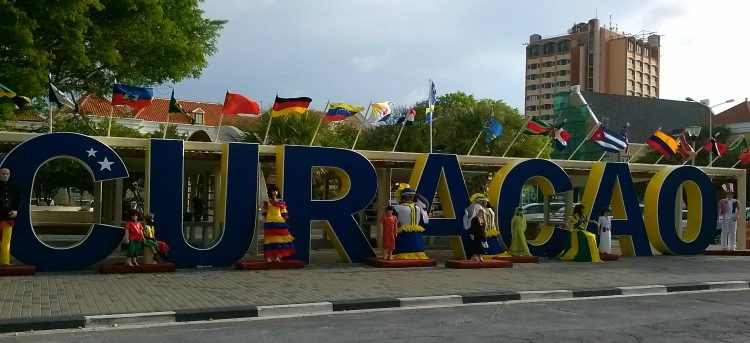Tachyk Nahar studies Cultural Anthropology at Utrecht University and specializes in the topics gender, sexuality, and race. She interned at the New Urban Collective and currently works on her bachelor research on gender in online social spheres of video games. Tachyk emigrated from Curaçao to the Netherlands in 2013. For antropologen.nl she wrote this blog about “The Antilles’ and why we should all stop using this term.
The 10th of October 2017 will mark seven years since the dissolution of the Netherlands Antilles; still, I frequently hear people in the Netherlands use the terms “Antilles” and “Antillean”. My general experience, in the three and a half years I’ve lived here, has been that Dutch people (especially those who are White) often do not know and do not care for what happens in their ex-colonies. Truly, people here don’t seem all that aware of the significance of the fact that the Kingdom of the Netherlands once had colonies, and now has three independent island-countries and three new municipalities. The “Netherlands Antilles” no longer exist. But to understand my opposition to the term, let’s start with a bit of recent history.
The Netherlands Antilles were comprised of six islands: Aruba, Bonaire, Curaçao, Saba, St. Maarten, and St. Eustatius and were known under the banner Netherlands Antilles from 1948 to 1986. In 1954, The Kingdom of the Netherlands got a new constitution in which the Netherlands Antilles were for the first time recognised as a country within the Dutch Kingdom rather than being a colony.
Now the way this worked for a long time was that there were two layers of government (three, if you count the Netherlands along, but let’s leave that aside for the moment). On each islands, we had the “bestuurscollege” (government), and the “eilandsraad” (parliament). A layer above that, we had the “ministerraad” (government) and the “Staten [van de Nederlandse Antillen]” (parliament), which accounted for all the islands. If you’re already thinking that that’s a bit confusing, we also, of course, had a “Gouverneur” (governor) who stood above that as a figurehead representing the monarch of the Dutch kingdom. And above that, of course, we had the Dutch government and parliament with its own complications.
On the 30th of May 1969, there was a revolt on Curaçao which spawned a political party, Frente Obrero Liberashon 30 di Mei (Labour Liberation Front), and for the first time in forever, we got our first Black Statenlid (Parliamentarian for the Netherlands Antilles). Unfortunately, not much of the politics changed.
Three decades after the new constitution, Surinam won its independence in 1975. That has its own history that I can’t cover right now because I do not possess enough information about it. Then, in 1986, Aruba gained Status Aparte, which does not mean independence so much as that Aruba became a special administrative region within the Dutch Kingdom, but apart from the Netherlands Antilles. Hurrah.
The Dutch eventually promised autonomy to the Netherlands Antilles. Finally, through a referendum, Aruba, Curaçao, and St. Maarten became constituent countries, whereas Bonaire, Saba, and St. Eustatius became special municipalities. The dissolution of the Netherlands Antilles happened on the 10th of october 2010. So why exactly does the term “Antillean” bother me?
Well, if you were paying attention, you may have noticed that the Antilles were a completely artificial creation to make it easier for the Dutch to rule over a set of islands which nowadays they seem to think of as simply destinations for a vacation, or a nice sunny place to start a new life. The crux of the problem is that the term “Antillean” allows people to gloss over the differences between the islands.
Firstly, by speaking of the “Antilles” and “Antilleans”, it’s easy to imagine one cohesive group where none exists. Sure, we can come together under the banner of the Antilles and strive for goals that benefit all, but the label “Antillean” simply erases the differences, the issues, and the discrimination present amongst ourselves. It allows us to look away from internal problems and pretend we’re one happy band of islands.
Just look at the way the government worked during the era of the Antilles. Curaçao alone had fourteen parliament seats of the twenty-two. It’s no small wonder that Aruba wanted out that considering the sheer unfairness of it.
Secondly, when one is in the Netherlands, it quickly becomes clear that “Antillean” is code for Curaçaoan. Perhaps it’s because we are the most overrepresented ones of the bunch; I cannot even begin to imagine how annoyed everyone else is to be lumped in together with us, to not be recognised as individual groups from other islands, as miniscule as the differences may seem. Whenever research is done and the researchers use the label “Antillean”, I ask myself whether that is truly representative, given that there are six islands to pick from, and when I look at the participants I can immediately tell they’re all from one island: Curaçao. With some luck they’ll be Aruban. It’s like no other islands exist.
Thirdly, to bring out the big guns, it is racist beyond belief to lump us all together under this term. “Antillean” has very nearly become its own race, often tied with criminality, promiscuity, tardiness, and laziness. When internal differences no longer matter, when they cannot be celebrated, you know you have a problem. Recognise us for who we are not for who a neo-imperialist system made us out to be.
So for me there is one thing left to say: The Netherlands Antilles don’t exist anymore. There is no need to speak of “Antilleans”, when one can easily be more specific.

